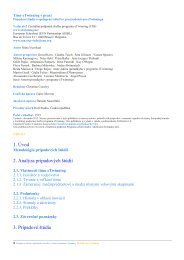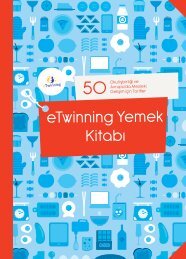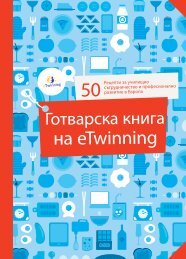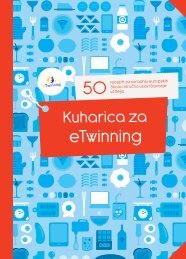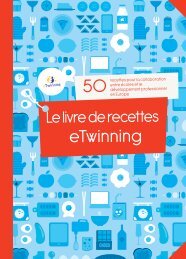itec - European Schoolnet
itec - European Schoolnet
itec - European Schoolnet
You also want an ePaper? Increase the reach of your titles
YUMPU automatically turns print PDFs into web optimized ePapers that Google loves.
iTEC Project<br />
Title: ITEC-D10_2_V1-1 041102012.Docx<br />
• Multi-attribute content preference modelling: they interpret and model multi-attribute<br />
descriptions provided by users on an element to use them to recommend elements most<br />
adapted to their preferences.<br />
• Multi-attribute content search and filtering: users are allowed to specify their<br />
preferences for certain attributes through search processes. From the data obtained, they<br />
recommend elements satisfying the search and/or filtering criteria most adapted to users’<br />
preferences.<br />
• Multi-criteria rating-based preference elicitation: user preferences are collected from<br />
the element ratings according to several criteria. Recommendations to specific users are<br />
based on their own ratings and other users’ ratings.<br />
According to this classification, and after analysing the behaviour of classical recommenders, we<br />
could say that most of them may be studied as multicriteria recommendation systems; mainly in<br />
the case of knowledge-based and content-based systems due to the way they model users and<br />
elements.<br />
1.2.2. iTEC SDE Recommendation System<br />
As discussed above, the SDE recommendation process is organized in three clearly separated<br />
stages: pre-processing, filtering and sorting of results according to the computed relevance. No<br />
matter this last stage being the most important, we will also discuss the processes taking place<br />
during the other two stages, as they provide the result candidates. Therefore, we will briefly<br />
introduce in Section 1.2.2.1 the initial pre-processing and filtering stages, and we will devote<br />
Section 1.2.2.2 to discussing the recommendation algorithm implemented by the SDE according to<br />
the multicriteria model already introduced. Finally, we will present in Section 1.2.2.3 the factors<br />
considered to compute the relevance of Tool, Person and Event resources, which were collected<br />
as a result of the third iteration of Control Boards from the contributions of iTEC WP<br />
representatives, as discussed in Appendix II.<br />
1.2.2.1. Initial stages<br />
From the input data used to obtain a sorted list of recommended resources, i.e. a requirement from<br />
a Learning Activity and a context for its implementation (i.e. LARGContext), the SDE performs a<br />
semantic pre-processing to generate a semantic graph combining that information with additional<br />
related data in the knowledge base. In this way, we generate an “extended requirement”<br />
simultaneously modelling the Learning Activity’s requirement, the LARG Context and other<br />
properties extracted from the knowledge base. 10 This pre-processing phase isolates the<br />
information needed to query the rest of the data in the knowledge base to reduce both the spatial<br />
and temporal complexity of the final recommendation phase.<br />
Once the input parameters have been consolidated, the filtering phase is devoted to reducing the<br />
number of resources in the knowledge base to those potentially relevant to perform a given activity.<br />
This restriction of resources improves performance, as the volume of data to be processed during<br />
the sorting phase is dramatically reduced. From the specification of a given “extended resource”, a<br />
semantic query is constructed and executed to mark those resources whose properties are fitted to<br />
10 For example, the geographical location of a school can be retrieved from the Technical Setting in the<br />
LARG Context through the existing relation between the Technical Setting and the school.<br />
Page 41/96






